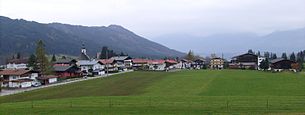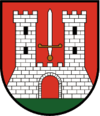Itter (Tyrol)
|
Itter
|
||
|---|---|---|
| coat of arms | Austria map | |
|
|
||
| Basic data | ||
| Country: | Austria | |
| State : | Tyrol | |
| Political District : | Kitzbühel | |
| License plate : | KB | |
| Surface: | 10.42 km² | |
| Coordinates : | 47 ° 28 ' N , 12 ° 9' E | |
| Height : | 703 m above sea level A. | |
| Residents : | 1,177 (January 1, 2020) | |
| Postal code : | 6305 | |
| Area code : | 05335 | |
| Community code : | 7 04 07 | |
| NUTS region | AT335 | |
| Address of the municipal administration: |
Dorfplatz 1 6305 Itter |
|
| Website: | ||
| politics | ||
| Mayor : | Josef Kahn (Rural Itter) | |
|
Municipal Council : (2016) (13 members) |
||
| Location of Itter in the Kitzbühel district | ||
 Look at Itter |
||
| Source: Municipal data from Statistics Austria | ||
Itter is a municipality with 1177 inhabitants (as of January 1, 2020) in the Kitzbühel district in Tyrol ( Austria ). The community is located in the judicial district of Kitzbühel .
geography
Itter lies on a terrace above the Mühltal and the Brixental . The settlement extends over several hamlets and scattered settlements.
Community structure
Itter consists of a single cadastral municipality and village of the same name .
Neighboring communities
| Kirchbichl ( District Kufstein ) | Söll ( district of Kufstein ) | |
| Wörgl ( district of Kufstein ) |

|
|
| Hopfgarten in Brixental |
history
The current municipality was already around 1500 BC. Settled . Archaeological finds show that the history of the settlement stretched back to the Romans .
In the year 902 the Brixental and also Itter (Itterdörfl), mentioned here for the first time as the " Uitaradorf ", came to the diocese of Regensburg , which appointed the Rapotons as bailiffs . At that time there was already a castle in Itter. The place was again mentioned in a document in 1241, when the Vogt Count Palatine Rapoto II waived his claims that he had received from the diocese of Regensburg. There has been a judge and caretaker at the castle since the 14th century . Together with the territory , they were sold by Konrad von Regensburg to Archbishop Pilgrim von Salzburg in 1380 .
During the reign of Emperor Maximilian the was archbishopric of Salzburg , the High jurisdiction sold through the Tyrolean possessions. Thus the judge from Itter had the blood judiciary back in his hands. The village of Itter itself formed a truce. Its taxes consisted mainly of services for the fortress .
In the 17th century, the offices of the caretaker and the court were merged, whereby the name was changed to "care court" and it was moved to Hopfgarten .
In 1805 Itter fell to Austria . Itter brought the Vienna treatise of 1809 to Bavaria . In 1816 Itter came back to Austria and was finally united with Tyrol .
Population development

economy
Itter lives today mainly from two-season tourism as well as from agriculture and small businesses. The community is located in the largest contiguous ski area in Austria, the ski association “ SkiWelt Wilder Kaiser - Brixental ”.
Culture and sights
- Itter parish church , built 1762–1764, in the vestibule of the altar of the former castle chapel
- The Itter Castle served as a fortress in the Middle Ages to monitor the Brixen Valley and fell from the 18th century. Rebuilt at the end of the 19th century, it was a branch of the Dachau concentration camp during World War II, also for prominent political prisoners who were liberated at the battle of Itter Castle on May 5, 1945. Today it is privately owned and not open to the public.
- The pilgrimage chapel on the Kraftalm at 1,355 m above sea level was inaugurated on September 25, 1983 by the then Archbishop of Salzburg, Karl Berg , and is dedicated to the patron saints of the dairy industry (Saints Lucio, Theodul and Fridolin).
coat of arms
On May 5, 1955, the Tyrolean provincial government awarded the municipality of Itter a coat of arms, the blazon reads:
- “A silver / white, two-tower tinned castle in red on a green field. Between the towers a silver, white, upright sword with a golden, yellow pommel. "
The castle is reminiscent of the former regional festivals of the Regensburg monastery. The judge's sword indicates the blood jurisdiction granted to the Itter court in 1514. The Tyrolean state colors white / red are also the colors of the Hochstift Regensburg, to which Itter owes its historical importance.
Personalities
- Hans Ager (* 1949), Austrian politician, former President of the Federal Council
- Sepp Kahn (* 1952), writer
Web links
- 70407 - Itter. Community data, Statistics Austria .
- www.itter.tirol.gv.at Website of the municipality
- Story of Itter
- Itter , in the history database ofthe association "fontes historiae - sources of history"
Individual evidence
- ↑ Martin Bitschnau , Hannes Obermair : Tiroler Urkundenbuch, II. Department: The documents on the history of the Inn, Eisack and Pustertal valleys. Vol. 1: Up to the year 1140 . Universitätsverlag Wagner, Innsbruck 2009, ISBN 978-3-7030-0469-8 , p. 86-87, no. 117 .
- ↑ Itter. SkiWelt Wilder Kaiser-Brixental Marketing GmbH, accessed on May 23, 2018 .
- ↑ Itter. Kitzbüheler Alpen Marketing GmbH, accessed on May 23, 2018 .
- ^ Municipal coat of arms , accessed on May 23, 2018








